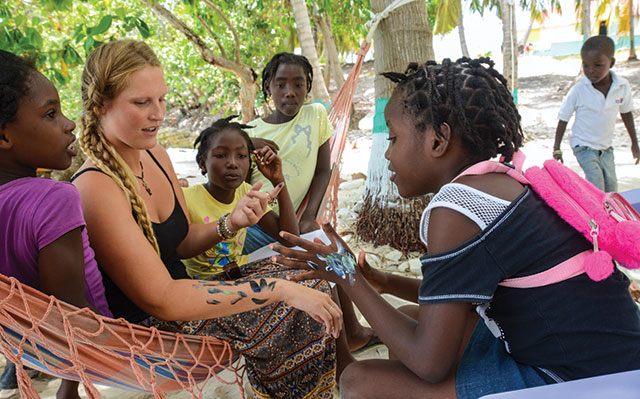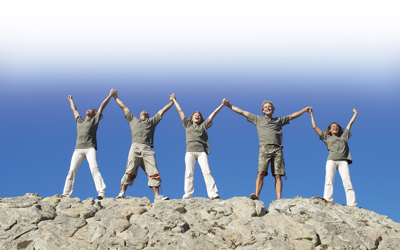The first thing I notice after my first meditation session is how shaky my legs feel after sitting with them curled under me or in a cross-legged position for a half day. Or so it seems. There are no clocks at the Northwest Vipassana Center in Onalaska, Wash.
Vipassana — a Pali term that means “to see things as they really are” — is a way of self-transformation through self-observation. To help minimize distractions, there are no books, no music, no writing, no eye contact, and no conversations. But that doesn’t mean there’s no sound.
There’s a surprising amount of noise in a room filled with meditators sitting for a 10-day silent retreat. Most of it takes place in each individual’s head: I can’t do this for one more minute! My legs are falling asleep. What is that smell?! It’s hot in here!
When my inner monologue winds down, I notice coughing, the whisper of the person next to me shifting position, and the snap of a match lighting incense.
That was my first visit to a Vipassana center, now more than 20 years ago. I arrived having never attempted one minute of meditation. But I was desperate for a space to sort through the grief from the death of my mother five months earlier. While I’m still working through that process, learning to really listen by paying attention has changed how I interact with the world and myself.
This unique skill brings me deep joy, and my desire to share it with others led me to return to another session at a different retreat center a few years later as a volunteer.
All Vipassana retreats and courses are free (including meals and lodging), funded by donations from those who have experienced the practice’s benefits and wish to give others the same opportunity. Teachers, assistants, and those who choose to serve in other capacities receive no financial compensation. (To find a retreat, visit www.dhamma.org.)
Helping to create a space for calm in an anxiety-producing and fragmented world made for a gratifying experience as a volunteer at a three-day retreat at a Vipassana center in Pecatonica, Ill. Being a witness and offering support — preparing meals and washing dishes, tending the onsite garden, and handling housekeeping tasks — for people struggling to unspool their minds from fear, perfectionism, and trauma helped me experience a profound sense of empathy.
Volunteer vacations like this are personally rewarding, adding a new dimension to what it means to travel.
They can be great adventures that immerse you in a new culture in a way that sightseeing can’t. They can help you connect with animals and nature in a way that’s different from watching the sun set behind a mountain (although I find this to be one of life’s great pleasures). Learning a new skill or language forces you out of your comfort zone in a way that sitting on a beach may not.
While there are countless options, these four adventures may inspire you to not just observe but engage with the world around you in a new way.
Renew the Beaten Path
Instead of simply taking a hike, help sustain the trail system by becoming a steward. The American Hiking Society offers weeklong service trips in parks and forests across the United States.
Join a crew of six to 15 volunteers for backpacking or day-hiking adventures. Recent volunteers helped construct boardwalks and turnpikes in Alaska’s Denali National Park and stabilized hurricane-damaged footpaths in the tropical paradise of Virgin Islands National Park. (No prior trail-maintenance experience is required, but trips do involve 30 to 40 hours of physical labor.)
Cost: $195–$350 includes food, entrance fees, and backcountry permits, as well as associated cabin or tent lodging fees (although you should plan on providing your own gear). www.americanhiking.org
Closer to Home: Get involved with a local trail group, association, or society, such as the Friends of the Blue Ridge Parkway in Roanoke, Va.; Lone Star Hiking Trail Club in Houston, Texas; or Chinook Trail Association in Vancouver, Wash. These organizations offer many opportunities for promoting and preserving local trails, trail lands, and the hiking experience.
You can also preserve any trail you’re using by following leave-no-trace etiquette. (For tips on treading lightly, read “Tread Lightly.”)
|
Get in Touch with a Museum Experience
Are you that person in the museum who is always tempted to ignore the “do not touch” signs? Then lend a hand restoring art in Italy.
Since 1989 Messors has worked with local professionals, community members, and volunteers to restore frescoes, architecture, canvas, wood, and stone statues throughout the country.
Lessons in restoration work include removing moss and calcification, touching up color, and fixing sculpture plaster. In addition, workshop participants learn to create their own frescoes by employing traditional techniques and materials.
Cost: About $3,420. The workshops combine art history with food anthropology (you’ll eat homemade regional dishes, picnic in the Italian countryside, and visit pizzerias). Cost includes lodging in shared bedrooms, transportation to and from airports, and tuition, as well as any museum and site entrance fees. messors.com
Closer to Home: Contact your local art, science, or history museums for information on volunteer programs or summer camps. Many, like the Science Museum of Minnesota, rely on volunteers of all ages to lead field trips, conduct demonstrations (such as tree-tapping), facilitate gallery activities, catalog items, and prepare lab specimens. Volunteers often earn discounts and free admission to exhibits and events. www.smm.org
|
Get Out of Your Shell
Costa Rica is known as one of the world’s happiest places — unless you’re a sea turtle. Facing threats that include climate change, boat traffic, domesticated animals, and ocean litter — which turtles too often ingest or get tangled up in — species populations have declined worldwide. Their numbers in Costa Rica alone are down by 90 percent since 1980.
Join a team of volunteers from Discover Corps and turtle-conservation groups along Costa Rica’s stunning Nicoya Peninsula for three days of cleaning beaches, collecting scientific data, counting turtle eggs, and ushering baby terrapins to the ocean (few survive the perilous journey from their nest without assistance).
Cost: $3,295/adult ($2,895/child); includes seven nights lodging; most meals, admissions and fees to parks, sites, and events; and transportation during the trip.www.discovercorps.com
Closer to Home: If you live near an ocean beach, turn off or redirect your lights. Sea-turtle hatchlings use moonlight and reflections to navigate to the water at night; artificial light from the shore causes them to head inland. It also discourages adult females from nesting. (Also, never interfere with nesting areas.)
Next time you’re heading to the beach, take along a trash bag to collect litter. You can document the dreck you find using the Clean Swell app. Free for iOS and Android, the app lets users log the weight of each item they collect and provides scientific information about the impact of trash on marine life.
You can also join thousands of volunteers who hit ocean, river, and lake beaches around the world annually to collect rubbish during the Ocean Conservancy’s International Coastal Cleanup day. In the past three decades, 12 million people have removed 220 million pounds of trash from beaches. Find or create an event near you by visiting www.oceanconservancy.org.
Reducing the amount of garbage you produce and chemicals you use on your lawn and in your home are easy steps you can take to make sure they don’t end up polluting waterways. (For tips on eliminating plastics, read “18 Ways to Live With Less Plastic.”)
|
Put Wanderlust to Work
If you can’t resist the call of the open road, join the Habitat for Humanity RV Care-A-Vanners team. Roam to one of the organization’s many job sites around the country and help build safe, affordable homes.
RV Care-A-Vanners can become master safety trainers and travel the country to Habitat for Humanity affiliates explaining safety regulations. Or they can join the Disaster Rebuild Team and be among the first wheels on the ground in communities devastated by fires, floods, hurricanes, or tornadoes.
Wherever your cross-country journey takes you, there’s a project in need of an extra pair of hands. The builds generally last about two weeks and include six to seven hours of work per day.
Cost: Individuals cover all their own expenses; motor-home parking fees vary by location. www.habitat.org
Closer to Home: Since 1976, Habitat for Humanity has helped improve the living conditions of more than 9.8 million people. With volunteer opportunities in nearly 70 countries, it’s easy to find a site near you or wherever you want to travel.
This originally appeared as “Hands-On Travel” in the May 2019 print issue of Experience Life.




This Post Has 0 Comments